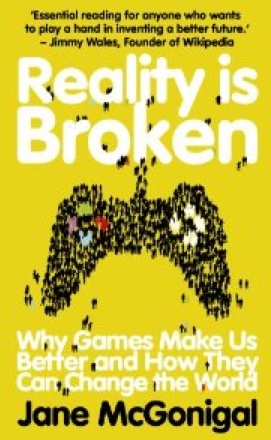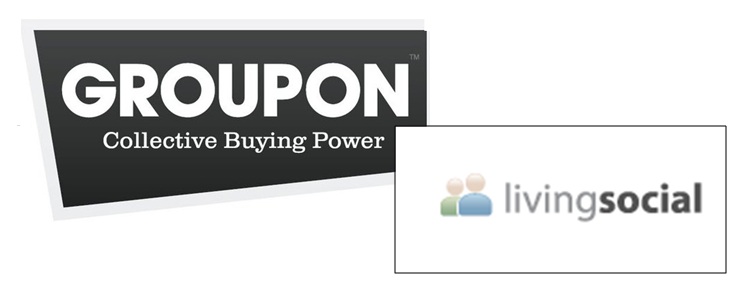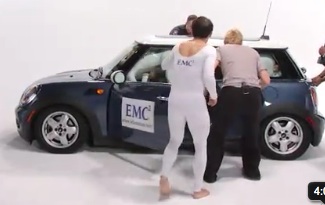
The Week in Geek™ – Jan. 30, 2011
The Inside Story of How Facebook Responded to Tunisian Hacks
 As Facebook became a nexus for organizing and sharing information around anti-government protests, Tunisian Facebook use has doubled, and new accounts have been created at a clip that on a US scale would run at 10 million a week. The site is so influential that Tunisian protesters have been seen carrying placards with Zuckerberg’s image. We shouldn’t romanticize or trivialize what’s happening abroad. The oppression is ghastly and brutal, as the Atlantic points out. But Facebook has enabled camera-phone wielding citizens to document murders and cast aside part of the censorship curtain. However, Tunisian authorities have also apparently taken drastic steps to censor the social network. On Christmas Day, Joe Sullivan, Facebook’s Chief Security Officer, noticed unusual activity involving the firm’s Tunisian users. The firm’s investigation subsequently revealed that Tunisian government authorities (via the nation’s ISP) were engaged in what amounted to an attempt to steal the Facebook passwords of an entire country. Many owners of hacked accounts reported their Facebook postings as purged, with incriminating reports of government brutality being removed. The Tunisian case shows the promise and dangerous role of technology in activism. The tool for organization was also used by the government to steal identities and silence dissent.
As Facebook became a nexus for organizing and sharing information around anti-government protests, Tunisian Facebook use has doubled, and new accounts have been created at a clip that on a US scale would run at 10 million a week. The site is so influential that Tunisian protesters have been seen carrying placards with Zuckerberg’s image. We shouldn’t romanticize or trivialize what’s happening abroad. The oppression is ghastly and brutal, as the Atlantic points out. But Facebook has enabled camera-phone wielding citizens to document murders and cast aside part of the censorship curtain. However, Tunisian authorities have also apparently taken drastic steps to censor the social network. On Christmas Day, Joe Sullivan, Facebook’s Chief Security Officer, noticed unusual activity involving the firm’s Tunisian users. The firm’s investigation subsequently revealed that Tunisian government authorities (via the nation’s ISP) were engaged in what amounted to an attempt to steal the Facebook passwords of an entire country. Many owners of hacked accounts reported their Facebook postings as purged, with incriminating reports of government brutality being removed. The Tunisian case shows the promise and dangerous role of technology in activism. The tool for organization was also used by the government to steal identities and silence dissent.
The Atlantic piece calls this keyboard logging, but I don’t think that’s really what’s happening – instead, the unencrypted username and passwords were being picked off as they traveled over the Tunisian Internet (the Internet equivalent of looking inside the envelopes of conventional mail). When Facebook recognized the issue, the service quickly enabled SSL security – the same kind of page-level encryption used by most online banks and credit-card-taking e-commerce sites. If web pages are encrypted on a PC or mobile device before being sent through the government’s ISP, then the dictator’s prying eyes simply see a scrambled transmission (consider it like putting transmissions inside an impenetrable envelope). You can tell when a web page is using SSL if the URL starts with “https” instead of just “http” and the little padlock icon in the corner of your browser is closed. Not in Tunisia but want to switch on SSL anyway? Log into Facebook and visit the “Account Settings” page, then click “Account Security” and click “Secure Browsing (https)”. As a bonus, this’ll help prevent some of the other Facebook WiFi hacks mentioned in an earlier Week in Geek. The solution is tenuous – according to The Atlantic, the Tunisian ISP could force a downgrade from https to http, but Facebook also implemented a “roadblock”, asking users to verify their credentials by identifying friends via photos to complete an account login – a little test that couldn’t be passed with just a stolen password.
As of this writing, there’s growing unrest in Yemen and Egypt (GigaOm discusses how Egypt has silenced the Internet). Calling the Tunisia Revolution a Facebook Revolution is, to quote Hear and Now, sort of like celebrating the bullhorn instead of the messenger. But the role of technology to push openness, organization, and fight misinformation is undeniable. Twitter didn’t unseat dictatorship in Iran, but is technology a catalyst for the Islamic crescent’s equivalent of the Eastern European revolutions of the late 80s? Also curious – Akamai’s State of the Internet (see below) noted Tunis beat out all other African cities to post the fastest rate of Net access on the continent.
How Video Games Are Infiltrating—and Improving—Every Part of Our Lives Video games are a big business. PwC estimates global video game sales will grow from $41.9 billion in ’07 to $68.4 billion in ’12. That’d exceed the worldwide take from film box office and DVDs. But games are becoming even more pervasive and influential. For a look, check out CMU Professor Jesse Schell’s talk from the 2010 DICE conference (Om Malik called it “the most mind-blowing thing I’ve seen in a long, long time”). FastCompany summarizes some of Schell’s ideas on how video game mechanics are being embedded in all sorts of products and services. “What were American Express points and frequent-flier miles but games that reward loyalty? Weight Watchers? A game. Fantasy football? A game stacked on top of a game that influences the way you watch a game.” The Ford Fusion has a virtual tree is embedded in the dash that grows the more you save on gas. Says Schell “They put a virtual pet in your car, he marveled, and it actually changes the way people drive!” You can imagine insurance companies offering points based on what you eat (or avoid), points for exercise, brushing your teeth. Sure there are thorny issues of privacy and security, but Moore’s Law means we’ll see more and more ways that your day-to-day life will become a series of behavior-influencing games.
Video games are a big business. PwC estimates global video game sales will grow from $41.9 billion in ’07 to $68.4 billion in ’12. That’d exceed the worldwide take from film box office and DVDs. But games are becoming even more pervasive and influential. For a look, check out CMU Professor Jesse Schell’s talk from the 2010 DICE conference (Om Malik called it “the most mind-blowing thing I’ve seen in a long, long time”). FastCompany summarizes some of Schell’s ideas on how video game mechanics are being embedded in all sorts of products and services. “What were American Express points and frequent-flier miles but games that reward loyalty? Weight Watchers? A game. Fantasy football? A game stacked on top of a game that influences the way you watch a game.” The Ford Fusion has a virtual tree is embedded in the dash that grows the more you save on gas. Says Schell “They put a virtual pet in your car, he marveled, and it actually changes the way people drive!” You can imagine insurance companies offering points based on what you eat (or avoid), points for exercise, brushing your teeth. Sure there are thorny issues of privacy and security, but Moore’s Law means we’ll see more and more ways that your day-to-day life will become a series of behavior-influencing games.
These dynamics may appeal to the generation of college students who are already world-class gamers. According to Jane McGonigal, Author of “Reality Is Broken: Why Games Make Us Better and How They Can Change the World” the average American will spend three times as much time playing video games as reading books, putting most ahead of the magical 10,000 hour practice threshold mentioned by Outliers author Malcolm Gladwell as necessary for virtuoso mastery (here’s McGonigal’s TED talk on using games to change the world).
The rise of gaming might worry some (especially parents), but some studies have shown a link between gaming and improved vision, hand-eye coordination, and decision-making. In one study, surgeons who gamed for at least three hours a week committed 37% fewer errors and worked 27% faster in laparoscopic surgery (which itself is game-like, requiring a joystick and tiny camera) than their non-gaming counterparts. Sure there’s a downside – games trigger the release of dopamine, a hormone also linked to driving gambling addiction and coke addicts. But the advance of fast/cheap computing almost certainly means the mundane will soon become the “fun”dane (ok, that was bad – sorry about that).
Apple Hits New Milestones: 10 Billion Apps Downloaded, 160 Million iOS Users and More Apple’s numbers are just freaky – all showing insanely huge growth that no one had predicted. Consider just a few of the stats from recent weeks. Last quarter revenue grew 71%, earnings grew 78%. The most bullish analyst predicted 7 million iPads sold in ’10. The actual figure was more than 2x that – 14.8 million. Some worried that iPad sales would cannibalize Mac sales, but those were up 23%. Says Apple COO Tim Cook (who is overseeing Apple while Jobs is on medical leave) “If this is cannibalization it feels pretty good“. Worldwide iPhone sales were up 86% over a year ago. The App Store recently passed 10 billion downloads worldwide. A Kent, UK mother drove the App Store odometer into its eleventh digit by downloading “Paper Glider”. She received a $10,000 iTunes gift card – but only after Apple’s second call (she hung up the first time thinking she was being punked). Do the math on 10 billion app downloads and this equates to roughly 62 apps for each of the 160 million iOS devices (iPhone, iPod Touch, iPad) in use. The only decline was in iPod sales, and those fell only 7%. Apple is now sitting on a jaw-dropping $59.6 billion in cash. That’s more liquid coin than any publicly listed US company. And it looks like global growth has phenomenal upside potential. Apple’s Greater China sales were $2.6 billion last Qtr. The firm’s four Apple stores in China saw more visitors and generated more rev. than any other Apple Stores!
Apple’s numbers are just freaky – all showing insanely huge growth that no one had predicted. Consider just a few of the stats from recent weeks. Last quarter revenue grew 71%, earnings grew 78%. The most bullish analyst predicted 7 million iPads sold in ’10. The actual figure was more than 2x that – 14.8 million. Some worried that iPad sales would cannibalize Mac sales, but those were up 23%. Says Apple COO Tim Cook (who is overseeing Apple while Jobs is on medical leave) “If this is cannibalization it feels pretty good“. Worldwide iPhone sales were up 86% over a year ago. The App Store recently passed 10 billion downloads worldwide. A Kent, UK mother drove the App Store odometer into its eleventh digit by downloading “Paper Glider”. She received a $10,000 iTunes gift card – but only after Apple’s second call (she hung up the first time thinking she was being punked). Do the math on 10 billion app downloads and this equates to roughly 62 apps for each of the 160 million iOS devices (iPhone, iPod Touch, iPad) in use. The only decline was in iPod sales, and those fell only 7%. Apple is now sitting on a jaw-dropping $59.6 billion in cash. That’s more liquid coin than any publicly listed US company. And it looks like global growth has phenomenal upside potential. Apple’s Greater China sales were $2.6 billion last Qtr. The firm’s four Apple stores in China saw more visitors and generated more rev. than any other Apple Stores!
As for US growth, many are anticipating more growth now that Verizon will sell a version of the iPhone. Thinking of making the switch to VZ? It may not be the best for international roamers (Verizon’s wireless standard works in fewer countries than AT&T’s). BusinessWeek also says AT&T has the speed edge “AT&T boasts speeds of 6 megabits per second—fast enough to download a song in four or five seconds, and roughly three times what most Verizon subscribers see” (remember current iPhones don’t support the speedy 4G rollout). As for the upside, the Verizon iPhone will act as a hotspot for up to 5 other devices!
Group Coupons: Boom or Bubble? Local businesses spend $133 billion each year on advertising. Group coupon sites want a chunk of that. The category is hot, but it’s also easy to copy. Groupon’s chief says some 500 imitators have popped up since his site got big – many copying details down to page design and font choice. But as we learn in class being an also ran often isn’t enough and so far, group coupons (which benefit from brand, scale, and distribution networks) are exhibiting the winner take all / winner take most dynamics of many other web businesses. The two biggest sites, Groupon and Amazon-backed LivingSocial account for 92% of the Web traffic in the “group buying” sector. The third-best-trafficked site, Mamapedia’s Sweet Deals, has just 1.4% of the market.
Local businesses spend $133 billion each year on advertising. Group coupon sites want a chunk of that. The category is hot, but it’s also easy to copy. Groupon’s chief says some 500 imitators have popped up since his site got big – many copying details down to page design and font choice. But as we learn in class being an also ran often isn’t enough and so far, group coupons (which benefit from brand, scale, and distribution networks) are exhibiting the winner take all / winner take most dynamics of many other web businesses. The two biggest sites, Groupon and Amazon-backed LivingSocial account for 92% of the Web traffic in the “group buying” sector. The third-best-trafficked site, Mamapedia’s Sweet Deals, has just 1.4% of the market.
Group coupon site traffic grew 610% from August 2009 to August 2010 and while sales are tough to come by (major players are all private), analysts’ best guesses put Groupon’s 2010 revenues at $500 million and LivingSocial’s at around $200 million. The big players are getting more attention. While Groupon allegedly spurned a $6 billion Google offer, the Chicago-based site raised $950 million in venture capital, a record-breaking amount. Investors include Sand Hill Road A-lister Kleiner Perkins, plus Morgan Stanley, Andreessen Horowitz, TCV (which we visit during undergrad TechTrek), and Russian moneybags DST. Some now peg Groupon’s value at $15 billion.
LivingSocial (which recently raised $135 million from Amazon), leveraged the Net’s biggest retailer to snare 1.35 million new customers, offering $20 Amazon coupons for just $10. The subsidy move is right out of the playbook of strategies outlined in our Network Effects Chapter, and reminds many of the moves used by an early PayPal. But do group coupons have the durability and dominance of other network effects businesses? We’ll see.
When It Wasn’t Stuffing Cars, EMC Was Doing Real Business The largest tech company in New England, storage giant EMC, has been busy – launching 41 products at a Jan. ’11 event. Among the offerings is the “VNXe, its first low-end offering, priced at less than $10,000 and aimed at small and medium businesses, a segment where Dell used to resell EMC equipment”. There was also some nifty stagecraft. A fourth-grader was brought onstage to demonstrate the managing and configuring of EMC gear using an iPad. And to demonstrate “efficient storage”, the firm pulled off one of high-tech’s weirder PR stunts (pictured) and jammed 26 leotard-clad dancers into a Mini Cooper (some sort of record). Also check out the Q&A with EMC CMO Jeremy Burton, which includes the firm’s response to concerns that storage-consuming Net giants like Google and Facebook shun EMC gear in favor of alternatives such as open-source Hadoop running on commodity hardware. Our BC students should read up – particularly given that EMC is such a significant recruiter at The Heights.
The largest tech company in New England, storage giant EMC, has been busy – launching 41 products at a Jan. ’11 event. Among the offerings is the “VNXe, its first low-end offering, priced at less than $10,000 and aimed at small and medium businesses, a segment where Dell used to resell EMC equipment”. There was also some nifty stagecraft. A fourth-grader was brought onstage to demonstrate the managing and configuring of EMC gear using an iPad. And to demonstrate “efficient storage”, the firm pulled off one of high-tech’s weirder PR stunts (pictured) and jammed 26 leotard-clad dancers into a Mini Cooper (some sort of record). Also check out the Q&A with EMC CMO Jeremy Burton, which includes the firm’s response to concerns that storage-consuming Net giants like Google and Facebook shun EMC gear in favor of alternatives such as open-source Hadoop running on commodity hardware. Our BC students should read up – particularly given that EMC is such a significant recruiter at The Heights.
Facebook, Growth, Asia Asia is Facebook’s fastest-growing region, with roughly 112 million of its nearly 600 million users worldwide. Growth is fueled, in part, by an abundance of Chinese-made mobile devices with prices pushing south of $150, and with regional Internet monthly subscriber fees in the range of $20 for unlimited data use. In the past two years Facebook has seen “quadruple-digit growth in Malaysia (1,000 percent), Thailand (4,000 percent) and Taiwan (7,500 percent)”. And the largest Facebook population outside the U.S. is no longer the U.K., it’s in Indonesia where, astonishingly, 80% of the population still lack conventional Internet access. GlobalPost says Facebook is essential “during epic traffic jams in Bangkok, Jakarta and Manila”. Our students recall that Facebook sped global rollout through crowdsourcing, asking users to suggest translations and vote for the best user-submitted responses. While Yahoo has offices in Vietnam, the Philippines, Thailand and other Asian nations, Facebook until recently only had Asian offices in Japan (India and Singapore opened in 2010).
Asia is Facebook’s fastest-growing region, with roughly 112 million of its nearly 600 million users worldwide. Growth is fueled, in part, by an abundance of Chinese-made mobile devices with prices pushing south of $150, and with regional Internet monthly subscriber fees in the range of $20 for unlimited data use. In the past two years Facebook has seen “quadruple-digit growth in Malaysia (1,000 percent), Thailand (4,000 percent) and Taiwan (7,500 percent)”. And the largest Facebook population outside the U.S. is no longer the U.K., it’s in Indonesia where, astonishingly, 80% of the population still lack conventional Internet access. GlobalPost says Facebook is essential “during epic traffic jams in Bangkok, Jakarta and Manila”. Our students recall that Facebook sped global rollout through crowdsourcing, asking users to suggest translations and vote for the best user-submitted responses. While Yahoo has offices in Vietnam, the Philippines, Thailand and other Asian nations, Facebook until recently only had Asian offices in Japan (India and Singapore opened in 2010).
Despite all this growth, Facebook is a non-player in China, where it is still subject to government ban. “The Facebook of China” is RenRen, with 165 million users (compared with Facebook’s roughly 150 million US users). The prior WiG pointed out that Zuck recently spent the holiday’s with his Chinese-American girlfriend of seven years. The world’s largest Internet population must clearly be on his mind.
Building the Supply Chain of the Future![]() Global market expansion is leading to wild distribution configurations. For example, “Nestlé is experimenting with the use of supermarket barges to sell directly to low-income customers along two tributaries of the Amazon River.” McKinsey Quarterly offers a nuanced look at crafting next-gen supply chains.
Global market expansion is leading to wild distribution configurations. For example, “Nestlé is experimenting with the use of supermarket barges to sell directly to low-income customers along two tributaries of the Amazon River.” McKinsey Quarterly offers a nuanced look at crafting next-gen supply chains.
Building world-class supply chains can be brutal. Energy rates are tricky to predict, with worldwide consumption likely to increase by at least 1/3 during the next decade (and influencing transportation prices in ways that may rocket-past pre-recession spikes). Commodity prices fueled by a worldwide developing-nation building spree, will continue to face upward pressure. Exchange rates seem to be on a never-ending whipsaw. McKinsey sees various tariff scenarios swinging the landed cost of parts manufacture as much as 20%. And labor rate fluctuations add to the instability. Labor rates in some Chinese cities rose 20% or more virtually overnight in the wake of labor disputes (and widely publicized worker suicides).
Planning involves considering tradeoffs of tough-to-predict cost, as well as service levels and innovation. McKinsey sees several forward-looking firms as fragmenting their supply chains into a portfolio of specialized assets, leveraging information in ways that embrace complexity, add to flexibility, hedge against uncertainty, and better serve customers. In one example, McKinsey cites a firm that ditched its one-size-fits-all supply chain into “four distinct splinters”. Chinese sourcing handled most high-volume products with stable demand (representing less than 10% of SKUs but the bulk of revenues). North America handled the rest of the product line, “including high- and low-volume [products] with volatile demand (assigned to the United States) and low-volume, low-demand-volatility SKUs (divided between the United States and Mexico)”. Manufacturing in the high-cost US market made sense for product lines where skilled factory workers, time-to-market and low-inventories were priorities. The JIT U.S. supply chain allowed the firm to ditch forecasting for a profitable portion of the product line, building product and retooling offerings served through the U.S. facilities based on demand. Results? Quality is up, costs down 15%, and lead time and service levels cut from an avg. of 10 days down to just 3 days.
State of the Internet![]() Akamai’s latest report is always chock-full of interesting stats. The Cambridge-based content distribution giant (which delivers about 20% of all web traffic) reports 535 million unique IP #s in use from 235 countries. Those addresses are super-concentrated, with 70% of unique IPs assigned to just 10 countries. China growth is up 30% in the past year and there are now more Chinese net users than the total number of all US citizens. By the time you read this we may be out of IP addresses (a topic covered in “The Internet is Almost Full” in our Telecommunications Chapter). For the current status see the NetCore IPv4 Exhaustion Counter and Hurricane Electric’s IPv4 and IPv6 statistics. Although we’ve run out of IP addresses, Akamai suggest there’s about a year’s worth of runway before regional ISPs exhaust addresses for their customers.
Akamai’s latest report is always chock-full of interesting stats. The Cambridge-based content distribution giant (which delivers about 20% of all web traffic) reports 535 million unique IP #s in use from 235 countries. Those addresses are super-concentrated, with 70% of unique IPs assigned to just 10 countries. China growth is up 30% in the past year and there are now more Chinese net users than the total number of all US citizens. By the time you read this we may be out of IP addresses (a topic covered in “The Internet is Almost Full” in our Telecommunications Chapter). For the current status see the NetCore IPv4 Exhaustion Counter and Hurricane Electric’s IPv4 and IPv6 statistics. Although we’ve run out of IP addresses, Akamai suggest there’s about a year’s worth of runway before regional ISPs exhaust addresses for their customers.
Another sign of globalization, Akamai says two of the speediest mobile providers in the world are in Russia (which has the highest avg. x-fer rate) and Slovakia (which posted the highest peak rate). Mobile is also an increasing source of cyber attack volume, especially as mobile devices work as hotspots for laptops (see the Verizon iPhone post above). Those interested in security may want to check out the report, which details examples of Akamai technology deflecting up to 95% of incoming traffic DDoS attacks, keeping key customers online. Oh yeah – and for those wanting more Akamai goodness, the firm’s CEO, Paul Sagan, will be speaking at BC on March 30th. Want more execs? Stop by on Feb. 23rd and you can see Motorola CEO Greg Brown. Kudos to Dean Ringuest & Bob Radin’s work on the BC MBA program’s events “The Manager’s Studio”
The Netflix of Europe (Lovefilm) now belongs to Amazon![]() Jeff Bezos’ firm owned 42% of the European DVD distribution powerhouse (which always comes up when I teach our Netflix Case to visiting Irish execs). Now Amazon owns it all – picking up the rest in a deal estimated at $312 million. Netflix isn’t in Europe but global expansion is on the horizon. LoveFilm does one-up Netflix, offering video games as well as DVDs & video streaming.
Jeff Bezos’ firm owned 42% of the European DVD distribution powerhouse (which always comes up when I teach our Netflix Case to visiting Irish execs). Now Amazon owns it all – picking up the rest in a deal estimated at $312 million. Netflix isn’t in Europe but global expansion is on the horizon. LoveFilm does one-up Netflix, offering video games as well as DVDs & video streaming.
Google Launches Algorithm To Fight Content Spam The prior week’s Week in Geek pointed to a growing chorus of complaints centered around the rise of useless, ad-laden ‘spam’ pages within Google’s top search rankings. In response, Google geeks have swung into action, revising algorithms that penalize content scrapers and raise the rankings of original content providers. Many of the ‘spam’ sites run automated software, which creates splogs, or ‘spam blogs’ which grab content from other pages and surrounds that content with Google ads, hoping frustrated page visitors will click pages and generate revenue that passes through Google onto the splog-page creator. Google is known for constantly tweaking its search algorithms – look for search quality-improving refinements to continue.
The prior week’s Week in Geek pointed to a growing chorus of complaints centered around the rise of useless, ad-laden ‘spam’ pages within Google’s top search rankings. In response, Google geeks have swung into action, revising algorithms that penalize content scrapers and raise the rankings of original content providers. Many of the ‘spam’ sites run automated software, which creates splogs, or ‘spam blogs’ which grab content from other pages and surrounds that content with Google ads, hoping frustrated page visitors will click pages and generate revenue that passes through Google onto the splog-page creator. Google is known for constantly tweaking its search algorithms – look for search quality-improving refinements to continue.
The criticism of so-called “content farms” is particularly interesting given the recent billion dollar IPO of Demand Media (now valued at more than the New York Times). Demand Media (perhaps best known for eHow), along with its kin, Associated Content (which Yahoo bought for $100 million last year), and others, pay attention to popular searches and the value of pay-per-click keyword advertising. Demand Media pays contractors to create ad-attracting content based on those keywords. A good model when content is of a high-quality, but a spam generator if content is deemed less valuable. Demand Media’s IPO acknowledged this risk in it’s S-1 filing that the firm may suffer if search firms (read Google) rework their “methodologies and metrics for valuing the quality of Internet traffic and delivering cost-per-click advertisements”. See that, Finance majors? Paying attention to search algorithms isn’t just for the marketing folks – it determines the durable value of a recent, widely-covered IPO, and it may influence whether or not you want to short the stock.
A Bully Finds a Pulpit on the Web Those following how Google responds to search quality criticisms might also note the firm’s response to the egregious case of the eye-wear distributor that was gaming Google’s PageRank algorithms by being bad to customers. The New York Times reports that a Brooklyn-based e-commerce site that sold eyeglasses (among other products) would engage in regular campaigns of customer harassment that included expletive-filled rants and shocking, unprintable physical threats against complaining customers. You’d think this would tank a firm, but the site saw its ranking swell to the “gold medal podium” of first page search listings on Google. This happened because Google ranks sites according to the influence of pages that link to that site. And apparently gripe-sites like GetSatisfaction, ComplaintBoard, and ConsumerAffairs are very influential. Google rankings didn’t discriminate on bad vs. good comments, prompting the owner of the online eye-wear shop to gloat online “I just wanted to let you guys know that the more replies you people post, the more business and the more hits and sales I get. My goal is NEGATIVE advertisement.” The strategy was so effective that when Googling the names of many eye-wear designers this bad-apple e-commerce site appeared before the sites from the designers themselves! Notably, the Brooklyn-baddie behaved himself through the affiliate he runs on Amazon since Bezos’ firm will give a swift boot to dealers with a bad rep.
Those following how Google responds to search quality criticisms might also note the firm’s response to the egregious case of the eye-wear distributor that was gaming Google’s PageRank algorithms by being bad to customers. The New York Times reports that a Brooklyn-based e-commerce site that sold eyeglasses (among other products) would engage in regular campaigns of customer harassment that included expletive-filled rants and shocking, unprintable physical threats against complaining customers. You’d think this would tank a firm, but the site saw its ranking swell to the “gold medal podium” of first page search listings on Google. This happened because Google ranks sites according to the influence of pages that link to that site. And apparently gripe-sites like GetSatisfaction, ComplaintBoard, and ConsumerAffairs are very influential. Google rankings didn’t discriminate on bad vs. good comments, prompting the owner of the online eye-wear shop to gloat online “I just wanted to let you guys know that the more replies you people post, the more business and the more hits and sales I get. My goal is NEGATIVE advertisement.” The strategy was so effective that when Googling the names of many eye-wear designers this bad-apple e-commerce site appeared before the sites from the designers themselves! Notably, the Brooklyn-baddie behaved himself through the affiliate he runs on Amazon since Bezos’ firm will give a swift boot to dealers with a bad rep.
Trying to push down bad-apple sites is a tricky problem to fix. Try to screen out criticism of a politician, or a firm like BP in the face of the oil spill, and it’d look like censorship or it might hide potentially sought-after content. But there are solutions. Ratings from Yelp and other services now accompany certain searches. Google, to its credit, immediately convened a team that deployed an algorithmic solution that more accurately screened for e-commerce sites that were rising in rankings as a result of their bad reps. Search isn’t done, but Google’s scale and expertise, plus the critical importance of quality results to customer retention, ensures the world’s biggest recipient of ad-dollars will constantly refine its efforts. Oh yeah, and the owner of the bad-apple e-commerce site? Arrested, thanks in part to the Times’ piece.
Eat People: And Other Unapologetic Rules for Game-Changing Entrepreneurs TechTrek friend and class speaker Andy Kessler has another new book out – “Eat People: And Other Unapologetic Rules for Game-Changing Entrepreneurs“. Kessler is a frequent contributor to the Wall Street Journal and is the author of several other books, including “Wall Street Meat” which covers his time as an award-winning tech stock analyst, and “Running Money”, a primer on how he turned $11 million into $1 billion as a co-head of Velocity Capital. Disclosure, I blurbed the back cover of “Eat People” – the pre-release I reviewed last summer was hugely fun! Unapologetic is the watch-word. Don’t expect any “kumbaya” moments in a Kessler book. But like all of Andy’s work, it’s a rollicking read that’s chock full of interesting examples and provocative analysis. I remain a big Kessler fan. Follow his work at http://andykessler.com and look for Eat People to drop on February 3rd.
TechTrek friend and class speaker Andy Kessler has another new book out – “Eat People: And Other Unapologetic Rules for Game-Changing Entrepreneurs“. Kessler is a frequent contributor to the Wall Street Journal and is the author of several other books, including “Wall Street Meat” which covers his time as an award-winning tech stock analyst, and “Running Money”, a primer on how he turned $11 million into $1 billion as a co-head of Velocity Capital. Disclosure, I blurbed the back cover of “Eat People” – the pre-release I reviewed last summer was hugely fun! Unapologetic is the watch-word. Don’t expect any “kumbaya” moments in a Kessler book. But like all of Andy’s work, it’s a rollicking read that’s chock full of interesting examples and provocative analysis. I remain a big Kessler fan. Follow his work at http://andykessler.com and look for Eat People to drop on February 3rd.
● ● ● ● ●
Got a friend who’s a management professor? Suggest that they subscribe to The Week in Geek at the top of https://gallaugher.com, and suggest they consider using the chapters & cases in “Information Systems: A Manager’s Guide to Harnessing Technology“. Thanks to all for helping spread the word!
